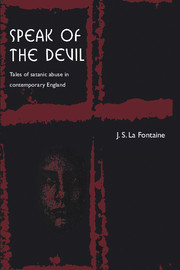Book contents
- Frontmatter
- Contents
- List of tables
- Acknowledgements
- 1 Introduction: the problem
- 2 The personification of evil
- 3 Witches, satanists and the occult
- 4 The extent of the allegations
- 5 The question of proof
- 6 Explaining belief
- 7 Children's stories
- 8 Confessions and tales of horror
- 9 A modern movement of witch-finders?
- 10 Aftermath and conclusions
- Notes
- Bibliography
- Index
10 - Aftermath and conclusions
Published online by Cambridge University Press: 05 June 2012
- Frontmatter
- Contents
- List of tables
- Acknowledgements
- 1 Introduction: the problem
- 2 The personification of evil
- 3 Witches, satanists and the occult
- 4 The extent of the allegations
- 5 The question of proof
- 6 Explaining belief
- 7 Children's stories
- 8 Confessions and tales of horror
- 9 A modern movement of witch-finders?
- 10 Aftermath and conclusions
- Notes
- Bibliography
- Index
Summary
The changes in the anti-satanist movement have continued to confirm the predominance of therapists. Since the cases that are given prominence now are those of adults rather than children, the focus has altered. In the case of adults there is nothing to require police or legal action unless the victims themselves initiate it, so that the question of material corroboration of the allegations of satanic abuse has gradually become less salient in public. The identities of the satanists are not pursued with such vigour and have faded into the shadows to become figures of evil with no real human identity. Paradoxically however, where extremes of evildoing are demonstrably proven, as in the case of the serial killer Frederick West, or the self-confessed Belgian kidnapper and murderer of young girls, attempts are made to prove a satanic connection retrospectively. Nevertheless the main focus of attention where adult survivors are concerned is on the victims rather than the perpetrators of satanic abuse. The main public debate concerns diagnosis, and the labels given the issues – false memory syndrome and multiple personality disorder – make it clear at once that they are concerned with psychological rather than religious matters. Their potentially divisive nature has made them the subject of concerned discussion within the psychological profession.
The first of these debates focuses on an element in the recounting of satanic abuse in childhood by adults – the nature of memory.
- Type
- Chapter
- Information
- Speak of the DevilTales of Satanic Abuse in Contemporary England, pp. 177 - 192Publisher: Cambridge University PressPrint publication year: 1998

